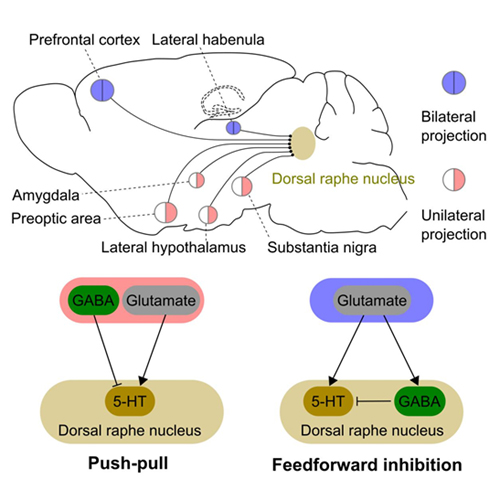Time:2017-03-22
A recent study published in Cell Reports systematically analyzed the circuit mechanism underlying dynamic control of serotonergic neuron in the rodent brain. This work was performed by researchers in Dr. SUN Yangang’s Lab at the Institute of Neuroscience, Chinese Academy of Sciences. The authors used adeno-associated virus (AAV) tracing, patch clamp recording combined with optogenetic method in brain slices to explore the functional inputs to serotonergic neurons and uncovered organizing principles of long-range inputs to the serotonergic neurons.
Dysfunction in serotonin system is involved in multiple mental diseases, especially mood disorders. The antidepressant drug Fluoxetine (Prozac), for example, is a selective serotonin reuptake inhibitor. The dorsal raphe nucleus (DRN) contains most of the forebrain-projecting serotonergic neurons, and is thought to be important for numerous cognitive processes. However, the circuit mechanisms underlying the controlling of serotonergic neurons in the DRN remain elusive.
In order to tackle this important problem, the SUN Lab systematically examined the property of six key upstream brain areas of DRN serotonergic neurons, including prefrontal cortex (PFC), lateral habenula (LHb), lateral hypothalamus (LH), preoptic area (POA), substantia nigra (SN), and amygdala. Researchers in SUN’s Lab found that all of the key upstream brain areas provided direct synaptic input to serotonergic neurons. These brain areas showed different topographic innervation patterns including both bilateral axonal innervation patterns (PFC and LHb) and unilateral innervation patterns (LH, POA, SN, and amygdala). More importantly, they also demonstrated that these upstream brain areas controlled the activity of serotonergic neurons with two distinct strategies. One group of brain areas employed a push-pull mechanism, where a single brain area provided both excitatory and inhibitory inputs onto individual serotonergic neurons. Another group of brain areas sent only excitatory projections to serotonergic neurons, and independently recruited feedforward inhibition for bidirectional control of the activity of serotonergic neurons.
In this project, the SUN Lab successfully determined the organizing principle of long-range circuits controlling the activity of serotonergic neurons. This work advanced our understanding of the mechanisms regulating the serotonin system, which could have important impact on studying the mechanisms of mental disorder.
This work entitled “Organization of functional long-range circuits controlling the activity of serotonergic neurons in the dorsal raphe nucleus” was published online in Cell Reports on March 21, 2017. It was carried out mainly by ZHOU Li, with help from LIU Mingzhe, LI Qing, DENG Juan, and MU Di, under the supervision of Dr. SUN Yangang at the Institute of Neuroscience, Chinese Academy of Sciences. This work was supported by the National Natural Science Foundation of China (No. 31371122, 81322015), and the Strategic Priority Research Program of the Chinese Academy of Sciences (Grant No. XDB02010000).

Figure legend: Top row, prefrontal cortex and lateral habenula provide bilateral axonal projection to dorsal raphe nucleus; amygdala, preoptic area, lateral hypothalamus, and substantia nigra provide unilateral projection. Bottom, illustration of the two major mechanisms for long-range projection controlling the activity of serotonergic neurons in dorsal raphe nucleus, convergent excitation and inhibition onto individual serotonergic neurons (left), and feedforward inhibition by recruiting GABAergic neurons in dorsal raphe nucleus (right).
 附件下载:
附件下载: